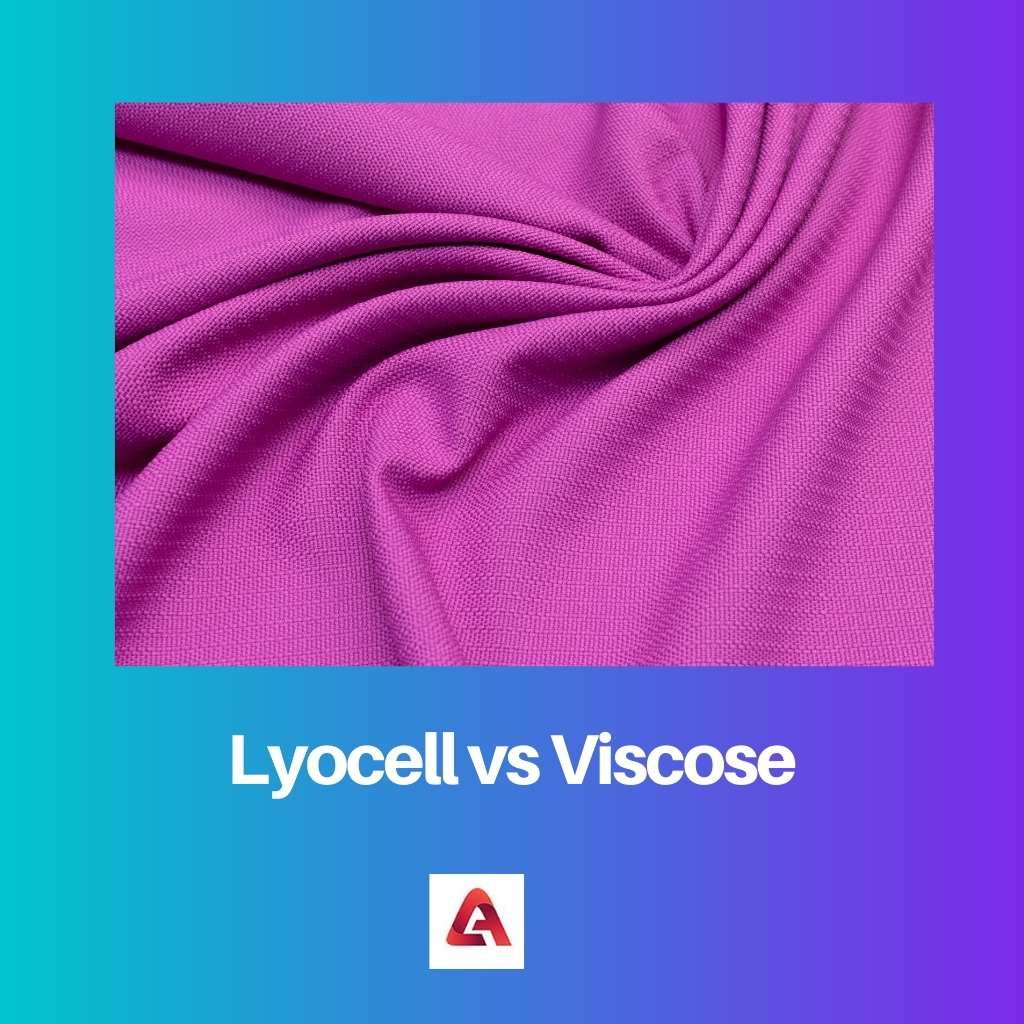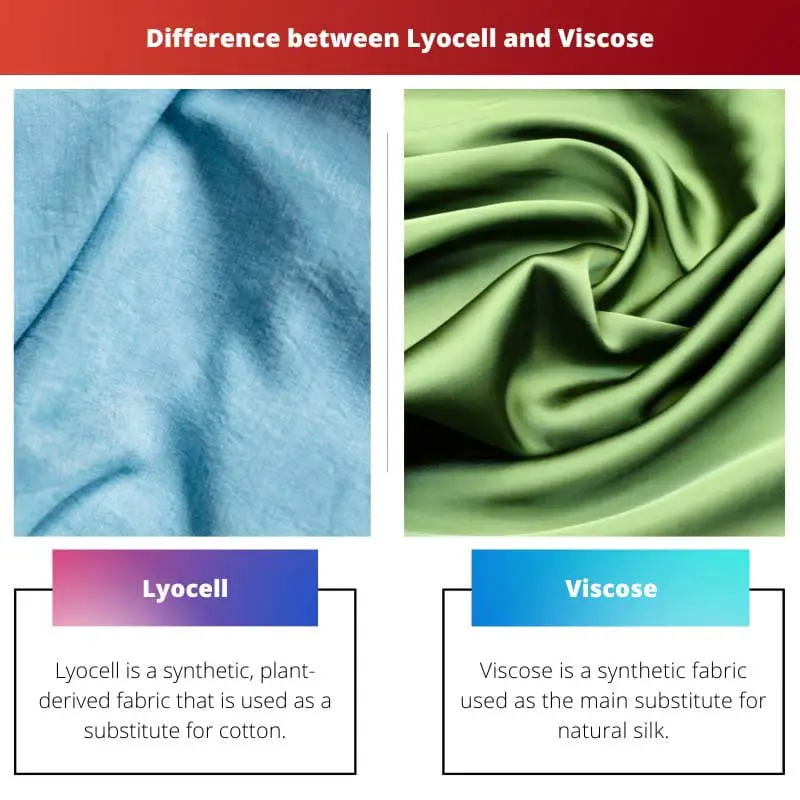With the developments in textile and chemical technologies, the need for traditional, regular fabrics has decreased as synthetic fabrics have replaced these conventional, “plant-based” materials.
Synthetic fabrics are more durable and cheaper than traditional fabrics. Because of their fibre structure, they can be used for many applications.
Key Takeaways
- Lyocell and viscose are both cellulosic fibers derived from plant sources. Still, lyocell is produced through a more environmentally friendly closed-loop process, while viscose is made using a more chemically intensive method.
- Lyocell fibres offer better moisture management, breathability, and strength than viscose fibres, making them more suitable for applications like activewear and bedding.
- Both fibers are popular alternatives to synthetic and non-renewable materials, offering natural, biodegradable, and versatile options for textiles and clothing.
Lyocell vs Viscose
The difference between Lyocell and Viscose is that Lyocell has better liquid-absorbing properties and is used as a chemical absorbent. On the other hand, Viscose is a synthetic fabric that is used as the primary substitute for natural Silk. It is very similar to Nylon in structure.

Lyocell is a synthetic fabric commonly used in the textile and chemical industries. It is derived from the cellulose obtained from wood pulp.
Thus it is a “plant-derived” synthetic material as chemical treatment is required for the purification of the material as well as to stabilize the structure.
Viscose is a fabric manufactured from cellulose. It is a synthetic fabric, and it closely resembles Nylon in its properties.
It is commonly used as the primary substitute for natural Silk because of its similarities in both appearance and texture. It is used in the garment and textile industries.
Comparison Table
| Parameters of Comparison | Lyocell | Viscose |
|---|---|---|
| Definition | Viscose is a synthetic fabric used as the primary substitute for natural Silk | Viscose is not a sound absorbent |
| Absorbent properties | Lyocell has high absorbing properties and is used as a chemical absorbent | Lyocell is used as a chemical absorbent, and hence it finds application in healthcare |
| Texture | Lyocell is a soft material, very similar to cotton in appearance and touch | Viscose resembles Nylon in its texture |
| Environment friendly | Lyocell is more environment friendly | Viscose is not environment friendly |
| Applications | Viscose is mainly used for making garments in textile industries | Viscose is mainly used for making garments in the textile industries. |
What is Lyocell?
Lyocell is a synthetic fabric commonly used as a substitute for cotton. It is a plant-derived synthetic fabric made from cellulose obtained from wood pulp.
The cellulose has to be treated to make the structure firm and purify the material.
The texture of Lyocell is very soft and resembles cotton in its appearance and touch.
Hence it is very commonly used as a dressing material for treating wounds.
Lyocell has excellent absorbing properties and is most commonly used as a chemical absorbent in industries such as healthcare and general chemical.
It has good absorbing properties and good draping properties compared to other synthetic fabrics.
As it is a plant-derived synthetic fabric, it is more environmentally friendly in its production than other synthetic fabrics.
It is derived from cellulose obtained from wood pulp, and the chemical process required for treating the cellulose is not harmful to the environment.
Because of its high absorbing properties in garment manufacturing, Lyocell is mainly used for making activewear and other sportswear garments.
The fabric is very light and soft to the touch, which makes it ideal for gym and athletic wear.
What is Viscose?
Viscose is a fabric manufactured from cellulose and is known for its silky texture. It is a synthetic fabric that is based on plant cellulose.
The cellulose is treated with sodium hydroxide and carbon disulfide to make the cellulose structure firm and clean.
The material is very similar to Nylon’s appearance and composition and has good shear resistance.
Due to this, it is used in many industries, from healthcare to general chemical and garment industries.
It is commonly used in garment and textile industries as the primary substitute for Silk.
As it has a silky appearance and touch, it is used in garment industries for making light and soft apparel products.
It is also highly durable and resistant to most chemical washing liquids and compounds.
As it is structurally similar to Nylon, it can also be used for making nets and wire-mesh products.
The most significant advantage of using Viscose is that it is very cheaply available.
The manufacturing process is not complicated but slightly hazardous to nature. As it is a cheap fabric, it is an affordable alternative to pure Silk and can be used for making imitation silk apparel.

Main Differences Between Lyocell and Viscose
- Lyocell is a synthetic, plant-derived fabric used as a substitute for cotton. Viscose is a synthetic fabric used as the main substitute for natural Silk
- Lyocell has high absorbing properties and is used as a chemical absorbent. Viscose is not a good absorbent
- Lyocell is a soft material, similar to cotton in appearance and touch. Viscose resembles Nylon in its texture
- Lyocell is more environmentally friendly. Viscose is not environment friendly
- Lyocell is used as a chemical absorbent, and hence it finds application in healthcare. Viscose is mostly used for making garments in textile industries

- https://www.sciencedirect.com/science/article/pii/S0014305704001715
- https://www.sciencedirect.com/science/article/pii/S0014305702001325
